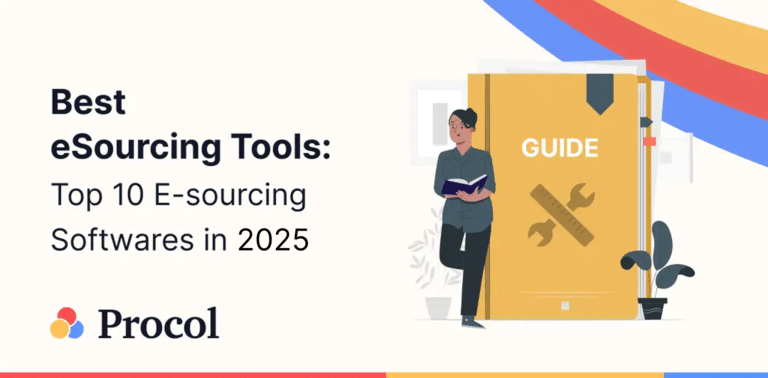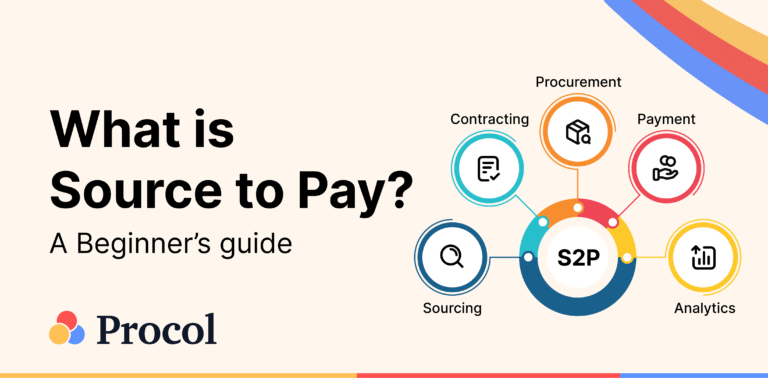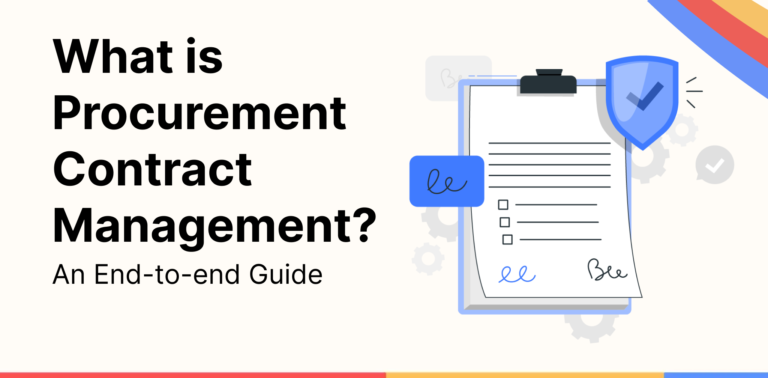Procol • February 24, 2025
A Step-by-Step Guide to Master Procurement Process

Introduction
These days, every business is looking for methods that may lead to profitability. To do so, businesses must think strategically when procuring goods and services. An organization must maintain timely procurement of goods and services to avoid falling behind its competitors.
So, what must be done to smooth business operations? Well, the solution is the procurement process. By implementing procurement strategies, businesses can easily enhance transparency, streamline operations, cut operational costs, etc. This overall procurement process flow strategy leads to business profitability growth and enhances competitiveness.
In this blog, we will learn more about how to automate your procurement process if it still relies on the old tools.
What is Procurement?
Procurement is the process of acquiring goods and services to keep business operations running smoothly. It optimizes a company’s buying process to cut costs and save time while nurturing vendor relationships. Procurement encompasses planning, negotiating, researching, making purchase decisions, sourcing, paying, and managing supplier relations. The goal is to invest in top-quality, cost-efficient supplies that provide the best value for the business. This comprehensive approach ensures a streamlined and effective procurement strategy.
Why is Procurement Crucial for a Business?
A business needs goods and services, including raw materials for product creation, software to simplify tasks, or services to keep things running. Procurement experts try to purchase products or services from suppliers at the lowest price while maintaining quality. This means they excel at negotiating, building business relationships, and smoothing the buying process.
With a streamlined procurement process flow, organizations can easily save on costs, minimize unnecessary spending, and analyze where budgets are most efficiently deployed. An automated procurement process also helps businesses save on processing costs.
Whether the strategy involves delivering low-cost products or high-quality offerings, procurement helps find suppliers that match these objectives. It also plays a crucial role in risk management by thoroughly examining potential suppliers’ history, financial stability, and ability to handle requests, thereby reducing the likelihood of supply chain disruptions.
Additionally, procurement contributes to maintaining ethical and sustainable business practices. By considering environmental policies and corporate social responsibility, companies can ensure their sourcing aligns with their values and protects their image.
What are the Key Components of the Procurement Process?
The procurement process comprises three key components: people, paperwork, and processes.
1. People: This component of the procurement process is accountable for starting and authorizing the procurement process steps. It includes procurement professionals, stakeholders from various departments, and accounts payable personnel. The people involved depend on the value of the goods or services being procured.
2. Paperwork: Physical or electronic records are essential at every procurement process step. These records are a repository of organizational knowledge about payment terms and supplier performance. They also provide a clear audit trail in case of disputes or audits, allowing businesses to easily track each procurement process step.
3. Process: The process is key in cutting costs and ensuring supplies arrive on time. A well-crafted, step-by-step approach boosts precision and punctuality by clearly defining tasks and deadlines for everyone involved. This helps avoid inefficiencies and mistakes that can impact profits or strain ties with suppliers.
What are the Various Types of Procurement?
Procurement has four fundamental types: direct, indirect, goods, and services. Each type serves a specific objective in an organization’s purchasing strategy.
| Direct Procurement | Indirect Procurement | Services Procurement | Goods Procurement |
|---|---|---|---|
| Acquiring goods and services for manufacturing purposes | Acquiring and buying supplies, products, or services for everyday business operations. | Also called strategic sourcing, it includes engaging consulting services to fulfil organizational requirements. | Purchasing physical products a company needs to operate. |
| For example, a smartphone manufacturer acquires chips, processors, and screens for their products. | For example, Investing in CRM software to streamline sales and customer management. | For example, signing a contract with a marketing consultant to set up paid advertising campaigns. | For example, food ingredients for a restaurant or raw materials for a manufacturing plant. |
What is the Procurement Process Flow Chart?
A procurement process flow chart shows each step of the procurement cycle. It makes the steps clearer and more streamlined, helping team members to understand and follow them better. This flowchart includes key parts like decision points, actions to take, approvals needed, and inputs/outputs.
To create an effective procurement process flow chart, organizations should follow these tips:
- Plan thoroughly, mapping out every step from initial need identification to final record-keeping.
- Keep the chart simple and clear, using straightforward language.
- Include all essential steps, from procurement software entry to auditing purposes.
- Utilize templates and tools that support creating flow diagrams.
- Regularly update the chart to reflect changes in the procurement cycle.
A typical procurement process flow chart might include the following steps:
- Complete the Purchase Requisition Form
- Obtain approval from relevant departments
- Issue Purchase Order
- Evaluate and select suppliers
- Receive and inspect goods
- Process invoice and payment
Difference: Procurement vs. Purchasing vs. Supply Chain
People usually mix procurement, purchasing, and supply chain management, but individually, they play a unique role in how businesses function. Let’s break down the differences between these three in the table below:
| Procurement | Purchasing | Supply Chain |
|---|---|---|
| Procurement encompasses the entire journey of obtaining goods and services, from identifying requirements to overseeing vendor relationships. | Purchasing is a procurement component, mainly dealing with the transactional elements of acquiring goods and services. | Supply chain management looks at the big picture, keeping an eye on the entire network of manufacturers, suppliers, and logistics companies that make and deliver products to customers.It influences how goods move from start to finish, ensuring everything runs along the way. |
| It influences finding the best suppliers, negotiating, and ensuring purchases align with company goals. | It impacts making buy orders, handling payments, overseeing agreements, and maintaining compliance. | It involves planning, manufacturing, sourcing, delivering, and returning products. |
| It focuses on choosing the supplier that works best for the company. This involves checking the quality, how fast they deliver, their prices, and how well they’ve done in the past. | It focuses on buying and selling parts of purchasing goods and services from a supplier. | This covers the whole process of buying goods and services, from procurement and purchasing them to consumption. |
What is the Procurement Process?
Procurement means finding, buying, getting, and paying for goods. It’s a complex business task that covers how companies identify, obtain, and handle the goods and services needed for operation. This process is critical to ensuring that businesses work smoothly and efficiently. The procurement process is acquiring goods and services required by an organization by saving cost, reducing time, and building supplier relationships. There are several procurement process steps:
- Needs Identification
- Specification of Requirements
- Supplier Identification
- Solicitation of Bids/Proposals
- Evaluation and Selection
- Contract Negotiation
- Purchase and Order Management
- Goods/Services Delivery
- Payment Processing
- Record Keeping and Documentation
- Supplier Performance Evaluation
11 Procurement Process Steps Important For Business Sucess
The process of buying goods and services involves a few important stages to make sure everything runs. The procurement process steps include:
1. Identify requirements for the goods and services: Figure out what goods and services are required by the company.
2. Purchase Request: After identifying the requirements, make an official request for the goods or services required to initiate the process.
3. Request Review: Check and approve the purchase request, ensuring enough money is in the budget.
4. Supplier Evaluation: The procurement team assesses and picks vendors based on company needs, looking at quality, cost, delivery times, and the supplier’s past performance.
5. Negotiation: After choosing suppliers, the procurement team negotiates a contract, picks one that fits the budget, and discusses contract details.
6. Order Management: The procurement experts then send a purchase order form to the chosen supplier and track the delivery.
7. Receive the Delivered Goods: After the vendor delivers the goods or services, the next step is checking the items to ensure everything matches what was ordered.
8. Compare Documents for Payment: After getting the bill, the company will check the order form and invoice to ensure all details line up.
9. Pay Suppliers: The company will then send payment to the vendor as agreed in the contract terms.
10. Invoice Approvals and Disputes: Compare the items received, supplier bill, and order form to ensure everything matches up.
11. Record Keeping: The procurement team will keep all necessary papers from purchase requests to approved bills in one place to help with audits.
What are the Stages of Procurement Process for Effective Purchasing?
Companies use seven main procurement process steps to buy goods and services. These procurement process steps provide a clear procurement plan, helping businesses make purchasing more effective.
1. Need Requirement:
The process starts by determining what each company department requires. This step lays the foundation for everything else in the procurement process.
2. Submit Purchase Request:
A formal purchase request is created and submitted after identifying what’s needed. This document outlines what goods or services the company wants to purchase.
3. Select Suppliers:
This key part involves doing homework on possible suppliers, asking for their prices, and reviewing their offers. Companies must pick suppliers that fit their needs and beliefs well.
4. Negotiation:
Once a supplier is chosen, it’s time to discuss the contract. This means negotiating the price, delivery timeline, and other essential points to ensure both sides mutually agree on the deal.
5. Finalize the Contract:
After both sides agree on terms, they sign the contract. This step makes the deal official and sets the stage for their business relationship.
6. Put the Contract into Action:
This part involves sending out the purchase order and overseeing the delivery of goods or services as agreed in the contract.
7. Maintaining Supplier Relationship:
The last step concerns ongoing supplier relations. This includes checking how well they’re doing and maintaining a good working relationship with them.
Top Procurement Process Challenges that You Must Know
As procurement evolves, organizations face challenges that impact efficiency, costs, and operations. Here are the key challenges:
1. Supplier management:
Supplier management focuses on building relationships for reliable, cost-effective goods and services. It includes performance monitoring, quality assurance, and contract management. Complexity grows with scale, balancing multiple relationships across regions.
2. Contract management:
Contract management involves negotiating terms and ensuring compliance. It helps maintain good relationships and avoid legal disputes.
3. Inflation:
Inflation increases costs, eroding profit margins and disrupting budgets. Managing it requires long-term contracts, diverse supplier bases, and market trend monitoring. Organizations need agile processes to adjust quickly to cost changes.
4. Inefficient processes:
Outdated, manual procedures waste time and resources. Streamlining these processes is key to reducing costs and improving procurement.
5. Invisible spend:
Invisible spending occurs outside controlled processes, creating gaps in financial planning. The challenge is gaining visibility into all transactions and ensuring policy compliance. Without this, budget overruns and non-compliant purchases can impact an organization’s financial health.
Best Practices for an Effective Procurement Process
Your organization should follow several best practices to create an efficient procurement process flow. These practices will boost productivity, cut costs, and improve the overall effectiveness of procurement activities.
1. Create a clear strategy
A clear procurement strategy is crucial. It aligns activities with business goals, considering market trends, supplier capabilities, and risk management. This guides decisions and highlights challenges and opportunities.
2. Make the process consistent
Standardizing procurement processes boosts productivity and reduces errors. Establishing consistent methods for purchase orders, contracts, and payments creates a uniform system for all team members, minimizing confusion and streamlining operations.
3. Bring in tech to speed things up
Using technology to automate procurement processes has an impact on saving a lot of time and cutting down on manual work. Take e-procurement systems as an example. They help simplify tasks like selecting suppliers and making purchase orders. This automation doesn’t just make things faster. It also cuts down on mistakes people might make. This lets your team spend more time on big-picture stuff that helps the company.
4. Set up clear ways to communicate
Clear communication is vital for smooth procurement. Establish accessible channels between teams and suppliers. Regular updates and openness prevent misunderstandings, enhance collaboration, and improve the overall process quality.
5. Keep an eye on supplier performance
Watching how suppliers perform is vital to making sure they live up to their promises and deliver top-notch goods and services. Setting up key performance indicators to help you measure suppliers’ performance. Looking at supplier performance against these benchmarks regularly allows your company to spot areas that need work and take action to fix things when needed.
6. Conduct regular supplier assessments
Regular supplier assessments ensure suppliers keep up with your company’s changing needs. These check-ups should look at how stable suppliers are, if they can deliver goods on time, and whether they follow all the rules they need to. Checking in helps keep your supply chain reliable and reduces possible problems.
7. Foster strong supplier relationships
Developing good connections with suppliers is key to getting the products and services your company needs at competitive prices. Keep in touch, give helpful feedback, and collaborate on projects. Solid ties with suppliers can result in better deals, improved service, and more innovative ideas, which helps your company in the long term.
Top 5 Procurement Software that is Best for your Business
Procurement software makes buying easier and cuts costs by automating the process. Check out these five top choices:
Procol:
Procol is the leading procurement system that offers a comprehensive suite of features with AI to handle an organization’s sourcing as well as procurement needs. Procol delivers all-in-one solutions to businesses’ needs. It manages the complete procurement lifecycle, from identifying needs to managing contracts, sourcing suppliers, and analyzing spending.
Vendr:
A SaaS buying platform that optimizes procurement, IT compliance, and vendor management. It offers price benchmarking, customizable approval workflows, and expert contract negotiation support.
Procurify:
Focuses on managing procurement and purchasing spend. Features include personalized approval workflows, vendor insights, and customizable budgets.
Oracle Procurement Cloud:
Offers in-depth reporting, automation, risk management, and supplier relationship features.
GEP Smart:
A comprehensive sourcing, procurement, and invoice payment suite. Key features include spend analysis, contract management, and supplier scorecards.
Conclusion
The procurement process is critical to gaining a competitive edge in a business. It lets businesses increase productivity and efficiency. Also, organizations can identify potential issues and implement best practices to streamline business operations.
Thus, having the right tools allows an organization to focus on its core competencies and achieve the desired procurement goals. The right procurement software, like Procol, can automate tasks and provide insights via key performance indicators.
Therefore, by staying informed and adopting new technologies, organizations can ensure their procurement process flow remains effective and efficient in the long run.
Explore more from Procol
Discover expert tips, how-to guides, industry insights, and the latest procurement trends.

Best eSourcing Tools: Top 10 eSourcing Software in 2025
Discover top 10 e-sourcing tools and esourcing platforms necessary for efficient...

What is Source-to-pay in 2025? An Ultimate Guide
Source to pay is the process of sourcing vendors to procure...

End-to-End Guide to What is Procurement Contract Management?
Wondering what is procurement contract management, then this end-to-end guide explains...












